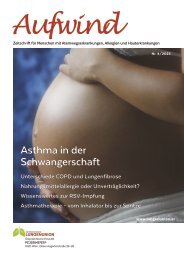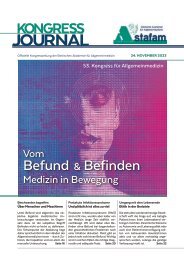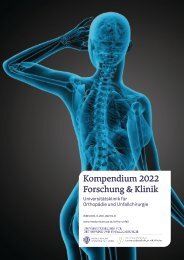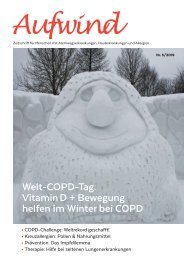Kompendium 2020 Forschung & Klinik
Das Kompendium 2020 der Universitätsklinik für Orthopädie und Unfallchirurgie von MedUni Wien und AKH Wien (o. Univ.-Prof. R. Windhager) stellt einen umfassenden Überblick über die medizinsichen Leistungen und auch die umfangreichen Forschungsfelder dar. Die Veröffentlichungen zeigen die klinische Relevanz und innovative Ansätze der einzelnen Forschungsrichtungen. Herausgeber: Universitätsklinik für Orthopädie und Unfallchirurgie MedUni Wien und AKH Wien Prof. Dr. R. Windhager ISBN 978-3-200-07715-7
Das Kompendium 2020 der Universitätsklinik für Orthopädie und Unfallchirurgie von MedUni Wien und AKH Wien (o. Univ.-Prof. R. Windhager) stellt einen umfassenden Überblick über die medizinsichen Leistungen und auch die umfangreichen Forschungsfelder dar. Die Veröffentlichungen zeigen die klinische Relevanz und innovative Ansätze der einzelnen Forschungsrichtungen.
Herausgeber: Universitätsklinik für Orthopädie und Unfallchirurgie
MedUni Wien und AKH Wien
Prof. Dr. R. Windhager
ISBN 978-3-200-07715-7
You also want an ePaper? Increase the reach of your titles
YUMPU automatically turns print PDFs into web optimized ePapers that Google loves.
TOP-Studien<br />
28<br />
prediction models. For example, our data showed BMI to be associated with<br />
multiple injuries or injury sites, however, never as predominant regression<br />
weight, when compared with other significant variables. On the other hand,<br />
the odds to suffer PFPS, patellar tendinopathy or a knee injury in general, are<br />
much higher in patients with knee malalignments. In other words, a present<br />
knee malalignment will contribute more to the risk to suffer from a RRI than<br />
BMI does, and therefore shows different clinical relevance. The patients<br />
were not able to provide sufficient data to properly address the question if<br />
different running footwear categories modify injury incidences. Interestingly,<br />
a relatively low proportion of runners with the pes valgus deformity wear<br />
motion-controlled traditional running shoes, even though they are recommended<br />
specifically for them.<br />
DI Dr. Emir Benca<br />
Author:<br />
Emir Benca holds a masters’<br />
degree from TU Wien and a<br />
PhD from Medical University of<br />
Vienna. He is the head of the<br />
Adolf Lorenz Lab for Biomechanics<br />
and coordinates the<br />
rapid prototyping cluster at<br />
the Department of Orthopedics<br />
and Trauma Surgery. He<br />
is currently working at the AO<br />
Research Institute Davos as a<br />
visiting scientist. Dr. Benca has<br />
participated in several half- and<br />
full marathons, as well as the<br />
Ironman 70.3 Austria in 2018.<br />
Sex Discrepancy<br />
A possible sex discrepancy (56% female, 44% male, ratio female: male: 1.25)<br />
was observed in this study, indicating either a generally higher number of<br />
female runners, women consulting a medical doctor sooner, or a higher injury<br />
rate in women than men. While earlier studies showed lower ratios (0.76),<br />
more recent literature shows a higher incidence in female injured runners<br />
(1.16), suggesting that running nowadays is not predominantly a male sport.<br />
Data from a nationwide survey have reported a ratio over the past five years<br />
between female and male Austrians, who run at least once a week, to be<br />
0.78 (range: 0.65 – 0.89). The „Vienna City Marathon” showed a finisher ratio<br />
of 0.52 (range 0.48 – 0.55) for the half- and 0.24 (range 0.22 – 0.28) for the<br />
full marathon (both increasing) over the same period. If the injury incidence<br />
across sexes was equal, the anticipated result would be a higher incidence of<br />
RRIs in men, especially across runners with higher total activity. Those runners<br />
are more likely to participate in long-distance races. However, the sex ratio in<br />
runners in the present study with five or more years of experience was 1.04. To<br />
investigate if there was a difference in visit rates to doctors among sexes, the<br />
patients were asked to indicate how often they visited a doctor per year. Women<br />
reported 2.6 visits, which is 0.35 times more than men, which corresponds to<br />
the well documented average yearly gynecologist visit rate of 0.41, which could<br />
explain the higher rate in medical visits in women. In summary, the female to<br />
male discrepancy seems to be based on a higher injury rate in women rather<br />
than a higher number of female runners in general, a higher participation rates<br />
in race events, or more frequent medical consultations in women.<br />
Conclusion<br />
In conclusion, running-related injuries are multifactorial, associated with<br />
personal data, training load, anatomic malalignments, and injury history. While<br />
it is impossible to define a one-fits-all formula to reduce the risk for RRI in<br />
general, runners with a high risk of a specific injury could be identified based on<br />
patient-specific training profiles and running gaits, as well as on pre-existing<br />
malalignments, such as scoliosis, patellar squinting, knee malalignments,<br />
and/or varus knee, with their diagnosis leading to an appropriate and balanced<br />
training adaptation. Furthermore, awareness of injury risks and prevention<br />
should be raised in running schools and by medical specialists.<br />
In the end, running has remained a popular activity over decades, even though<br />
it has been associated with a high incidence of overuse injuries. By presenting<br />
the injuries the authors did not aim to discourage from running, but to provide<br />
data for better understanding and to contribute to their prevention. We believe<br />
running is still beneficial in many respects, enriching, and simply fun.
















